

Project for 2003 St Valentines Day Massacre needed some searching for inspiration. I turned to the web after searching my stash of books. Since I was not allowed to touch my sewing room until some home renovations were complete, I kept my word and just threw things in from the door. Gees what a mess.
But in the
months of doing manual labor on the house (ok, painting, wallpapering, killing
carpenter ants and renovating bathrooms) I did take some time in the wee hours
of the night to surf for just the right portrait.
Somehow I
ended up on the website for the National Museum of Women in the Arts in
Washington DC. (http://www.nmwa.org/collection/portfolio.asp?LinkID=243)
There I found my inspiration. Lavinia Fontana (1552-1614), a female artist
in a male dominated Italian artist community.
I had done a
Spanish style doublet Elizabethan for an A&S project years ago. I loved the
fit, but was trying different eras and styles of garb so kept it as my best
dress. Years later, it still is.
So having
inspiration, it is time to find the pieces to the puzzle.
There are
photos below the documentation.
To skip
the documentation click
HERE
This dress was not
originally intended as an A&S entry, but it ended up being one.
Documentation for
Spanish/Italian Doublet dress. 2003
The
figures listed in the text have not been added, if you would like them, please
email me
ablackram@yahoo.com
To begin:
To begin any
project, one should turn to the old masters for inspiration. I turned to the
web after searching my stash of books. I did take some time in the wee hours
of the night to surf for just the right portrait. Somehow I ended up on the
website for the National Museum of Women in the Arts in Washington DC. (http://www.nmwa.org/collection/portfolio.asp?LinkID=243)
(see portrait on the below) There I found my inspiration. Lavinia Fontana, a
female artist in a male dominated Italian artist community. Her Portrait of a
Noblewoman (1580) painting was astounding. It is found in the National Museum
of Women in the Arts in Washington DC, and is not readily accessible. I sought
information from the museum, which was more than happy to help. From them I
got the electronic picture below and a slide of the painting. Slides, while
capturing copious amounts of information, lack the ability to be seen without
a projector. This was a feat in itself. I borrowed my father in laws projector
and nearly had the slide melted. I have therefore procured a newer projector
and saw for myself the intricate details which I will describe below.
This dress
style has been appealing for quite some time. I always imagined it to be more
difficult to pull off than it actually was. Upon researching what I thought to
be an open doublet overdress, I found that there was a combination of jerkin
with matching skirt and doublet and underskirt. The doublet and underskirt do
not necessarily match. This seems to be a fashion that was recognized in Spain
and Italy in the 1580’s to 1600’s. Research done by others concluded that only
a full kirtle was worn under the doublet and overskirt.(figure 8 # 3) Checking
into patterns derived from period sources tend to dismiss this claim. Algeca
and the a Milanese Tailor book(figure 5 & 8) at the V&A in London has a kirtle
with a square neck only and not a full doublet. This led me to more digging.
There are however clothing referred to as a jerkin and doublet combination.
This has also been a caption in source descriptions. In Queen Elizabeth’s
Wardrobe Unlocked for instance, Janet Arnold also refers to it as a skirt and
jerkin combination. (Figure 9)
The paintings
that I have primarily studied are the paintings by Lavinia Fontana, Portrait
of a Noblewoman (below), and Portrait of a Lady with a Lapdog (end of first
set of photos), as well as the painting of a Lady in a Blue Velvet gown c 1580
from a Milanese tailors album from the Biblioteca Querini-Stampalia in Venice.
(figure 6)
It has been
dismissed by some that this is a Ropa, or Spanish overgown.(Figure 10) Ropas
are loose fitting garments that tend to hang from the shoulders and do not
have the defined waist as shown in the jerkin and doublet combination. In
fact, piccadils are seen on the primary painting studied, Portrait of a
Noblewoman, as seen below. Therefore I tend to agree with Arnold in that this
is also a jerkin, or short sleeved doublet.
On to the
painting:
This is what
I have determined from the painting image shown above. The dress is made from
red velvet possibly silk, which is embroidered in gold and silver on the
doublet and skirt. As the Spanish overdresses had the skirt attached to the
doublet, (Patterns of Fashion, Pfaltzgraffin Dorothea, figure 2), I deduce
this in this dress as well. From being in Italy and most likely Florence, I
believe it to be done in a short pile silk velvet with the edges trimmed in
long pile silk velvet. (Patterns of Fashion, p113, figure 2) The over doublet
is slashed to show the doublet underneath. The skirt is either cartridge
pleated or knife pleated. As there are piccadils in the way, we cannot
determine for certain either way.
What I
did:
This project
is to take from the painting and dress it down for a matron of the merchant
class or lower nobility in approximately 1580 to be worn for good occasions
and not every day dress. For this reason I chose materials that are not as
expensive, as elaborate or not so bedecked. But it could be reasonably seen in
the 1580’s around the regions of Italy and Spain. For this dress, I chose
cotton velveteen as it resembles the pile sheen seen in the portrait. It was
also chosen primarily because of its resemblance to silk velvet found in a
burial (figure 2), also for its cost and washability.
As far as a
pattern is concerned, I used the graphed pattern from the back of Patterns of
Fashion for the Pfalzgraffin Dorothea Von Neuberg dress (figure 2) and revised
the collar to look like the doublet found in A Milanese Tailors Book by Juan
Algeca. (Figure 8) This integrates the high collar into the back panel and has
a palm sized collar attachment for the front of the doublet. This makes five
pieces to the doublet, one back, two front and two front collar pieces.
I chose a
trim which is still on order from last September,
 and had to make a
quick Sunday afternoon switch to get the dress done on time for the event I
was making it for. This current trim is gold and shimmers similar to the
embroidery in the painting. One may ask why I did not embroider the dress.
Simply, I did not feel that it would have been appropriate to a merchant/lower
nobility station. Also, this dress would take approximately 3 years to
embroider if done solely by myself. I will be satisfied at this point to just
use the trim. I attached the skirt with cartridge pleats and continued the
trim down the skirt as seen in the painting. As the trim shifted this way and
that even when done by hand, there are slight waves in the trim on the skirt.
I chose to stiffen the dress with linen and line it with a satin. There is a
modern boning material in the collar to help it stand up.
and had to make a
quick Sunday afternoon switch to get the dress done on time for the event I
was making it for. This current trim is gold and shimmers similar to the
embroidery in the painting. One may ask why I did not embroider the dress.
Simply, I did not feel that it would have been appropriate to a merchant/lower
nobility station. Also, this dress would take approximately 3 years to
embroider if done solely by myself. I will be satisfied at this point to just
use the trim. I attached the skirt with cartridge pleats and continued the
trim down the skirt as seen in the painting. As the trim shifted this way and
that even when done by hand, there are slight waves in the trim on the skirt.
I chose to stiffen the dress with linen and line it with a satin. There is a
modern boning material in the collar to help it stand up.
Upon
reflection, the next jerkin, a more Spanish style, will have a more period
stiffener to make it more evenly stiff. The front of the doublet is hook and
eye as seen in detail in Patterns of Fashion with various garments. (Figure 3)
The dress is not piped in a long pile material as it would have also
catapulted the wearer into another social class.
I chose to
use cartridge pleats as I wanted a really full skirt, and my pleats did not
work out right. Because of the cartridge pleats and the fact that the
piccadils are small and rigid, they tend to stick out from the waist instead
of laying down over the waist. This can be corrected on version two.
For
sleeves on the jerkin, I used the sleeve pattern from Algeca (figure 8)
and paned the sleeve. I then gathered the sleeve up to resemble, not
replicate, the short sleeve style in the Fontana portrait. The sleeve in the
Fontana portrait has a band around the bottom. I chose to do it this way to
have a different, yet period feel.
The
underskirt for this dress is aubergine embossed silk. This is the most
expensive part of the entire dress. For this reason the underskirt is not cut
in any way. The length of the skirt, the hem and the waistband are the exact
dimensions of the fabric. I loved the way the leaf and flower swirl in the
fabric picked up the light. In future, I am thinking of making this underskirt
into a doublet and sleeves. But for now, it is a beautiful underskirt.
The
doublet is patterned satin. I used this as it closely resembled the fabric
used in the painting. Please bear in mind that I had only a 1.5” photo of this
painting and had to make assumptions when I was in fabric mecca. I found after
blowing the photo up to 2x3’ that the fabric is embellished with ribbon, more
than likely silk. I had been given the real pearls that are on the sleeves of
this doublet. I chose to use them for sleeves as this doublet is not the main
part that will see the most possible soiling. The green faceted gems on the
sleeves are Swarofski crystals are primarily for contrast. They gave the
sleeves a more period feel to them without overbearing. The doublet is lined
with trigger for stability. It will be fully lined by hand with silk taffeta
when a suitable material is found. The pattern for this doublet and sleeves
came from Patterns of Fashion. (figure 2)
The corset
has been purchased by someone who could do it more reasonably than I.
Unfortunately, their sense of OK out the door differs from mine. Needless to
say, I still use it. It is based off of the effigy corset A Payre of Bodies.
The
chemise is silk gauze. Its pattern is from Margo Anderson. Primarily
because I wanted to try the chemise for another dress(see Alaina's Red
Bronzino Dress) and the silk gauze is so filmy. The collar is handsewn and is
missing a ruffle on the top. This will also be corrected in version two.
The
farthingale is from my first Elizabethan, done 7 years ago. It still holds
up to frequent wear. For this reason I thought it unnecessary to remake.
Ruff:
This ruff is also from my first Elizabethan and holds up to frequent wear. It
is out of a fine cotton and cotton lace. It is seen being worn with this type
of outfit in Figure 7.
Jewelry:
The jewelry on this outfit comes from various paintings and suppliers. The
largest and most vibrant piece is a plastic copy of the Hope diamond. While
this is not a period piece, it resembles some of the jewelry seen at the V&A
in the jewelry vault. The necklace, seen in the photos is by VonRosselar. It
is a reproduction of a piece in the V&A vault as well. The jeweled girdle is
modeled after the girdles found on the continent anywhere from 1500 to 1650.
The pearls are found in so many portraits of ladies, that it is difficult to
pin down any one. The most frequent use of pearls in a painting is that of
Elizabeth I. She was frequently painted with a long strand of pearls being
looped up in a fashionable brooch. The peridot earrings are from the paintings
of the Medicis primarily that of Eleanor of Toledo.
Things I have
learned from doing this dress. First I need a stiffer material to line the
bodice. Buckram is not an option due to the fact that this must be laundered.
So off to the fabric mecca I must go. I have learned that I like this style of
dress and will complete another version in the next year or two.
Following are
some photos taken when it was initially completed, please mind the fact that
dummy is not corsetable, nor small enough for this dress. Following those
photos are photos taken last week.
 |
 |
Original Painting I started drooling over
|
Underdoublet
|
 |
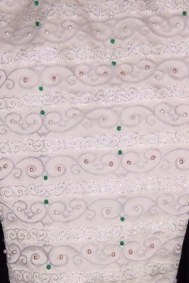 |
|
Underskirt
|
Sleeve
pearling up close
|
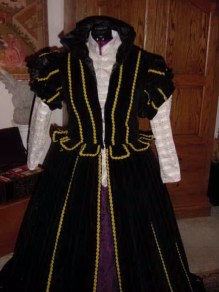 |
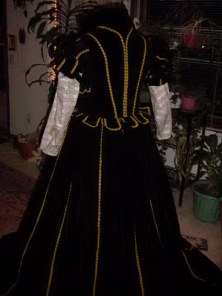 |
|
Overdress
|
Back of
overdress
|
 |
|
|
Close
up on back
|
A dress
showing an underdoublet
Click
on portrait to link to site
|
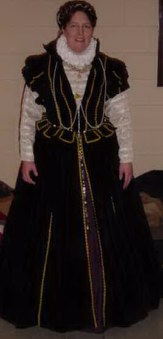 |
 |
|
me all
dressed up at Val Day 2003. More photos below
|
New
necklace I purchased from Jewels by Von Rosselar
|
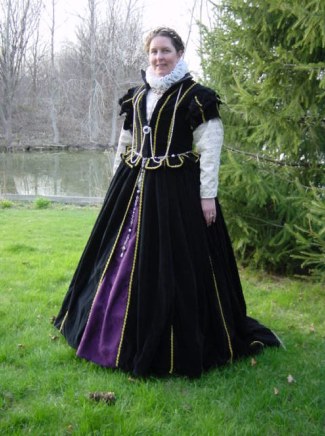 |
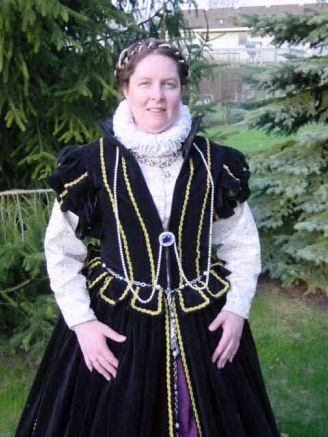 |
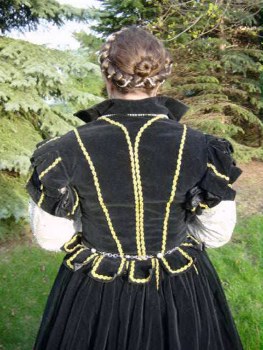 |
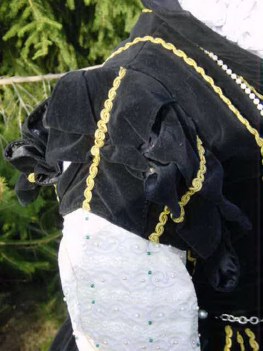 |
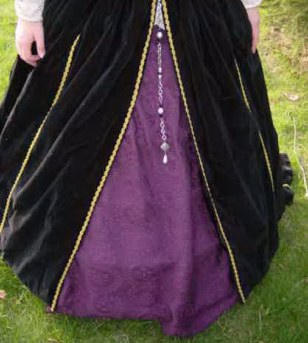 |
 |
 |
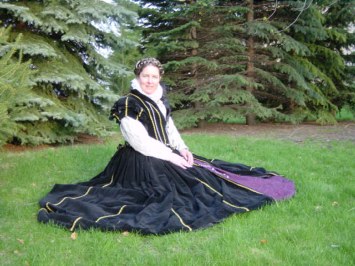 |
|
References:
Algeca,
Juan; Tailors Pattern Book 1589, Quite Specific Media, 1999.
Arnold,
Janet; Patterns of Fashion, McMillan, 1985.
Arnold,
Janet; Queen Elizabeth’s Wardrobe Unlock’d, W. S. Maney and Sons,
1988.
Davenport, Millia; The Book of Costume, Crown Publishers, 1948.
Ein,
Claudia; How to Design Your Own Clothes and Make Your Own Patterns,
Doubleday and Company, 1975.
Vecillio, Cesare; Vecellio’s Renassance Costume Book, Dover
Publications, 1977.
|
|

